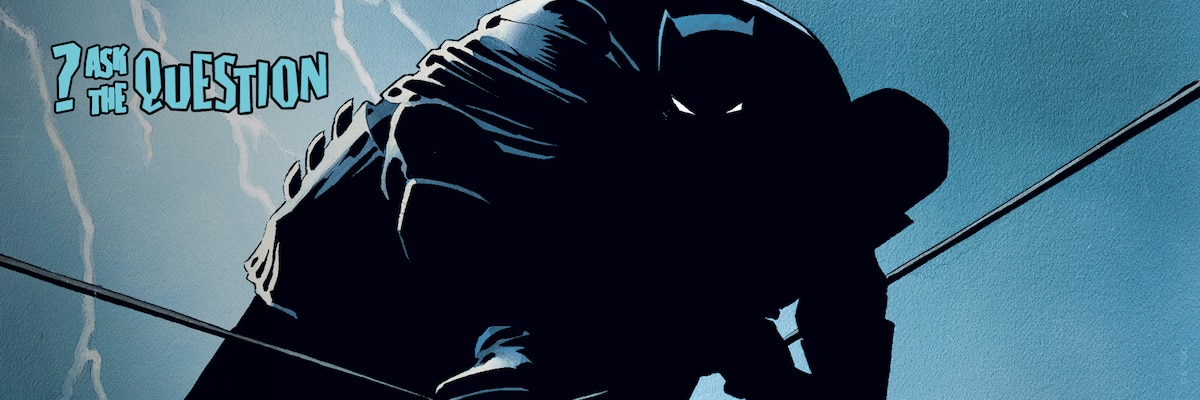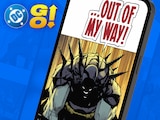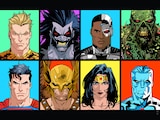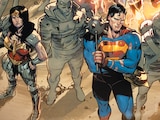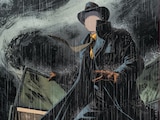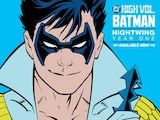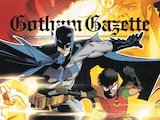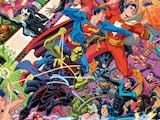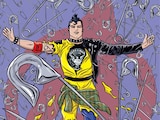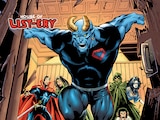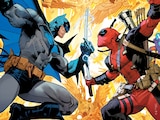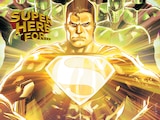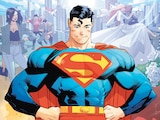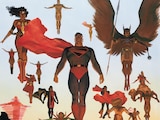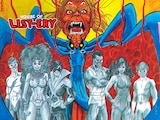It’s that time again. Welcome back to another edition of ASK…THE QUESTION, our column addressing every pressing mystery of the DC Universe you can think of—and probably a few you haven’t. I’m Alex Jaffe, better known to the DC Official Discord community as HubCityQuestion. It’s there that I take the vagaries and ambiguities about canon and comics history and do my best to untangle those pernicious snarls for you every day. Here, every month, we showcase just a few of the questions brought to my door. This month, with Batman Day ahead, I’ve made certain to include some recent questions focused on the Dark Knight. So, stick around, Bat-fans, and maybe you’ll learn something new.
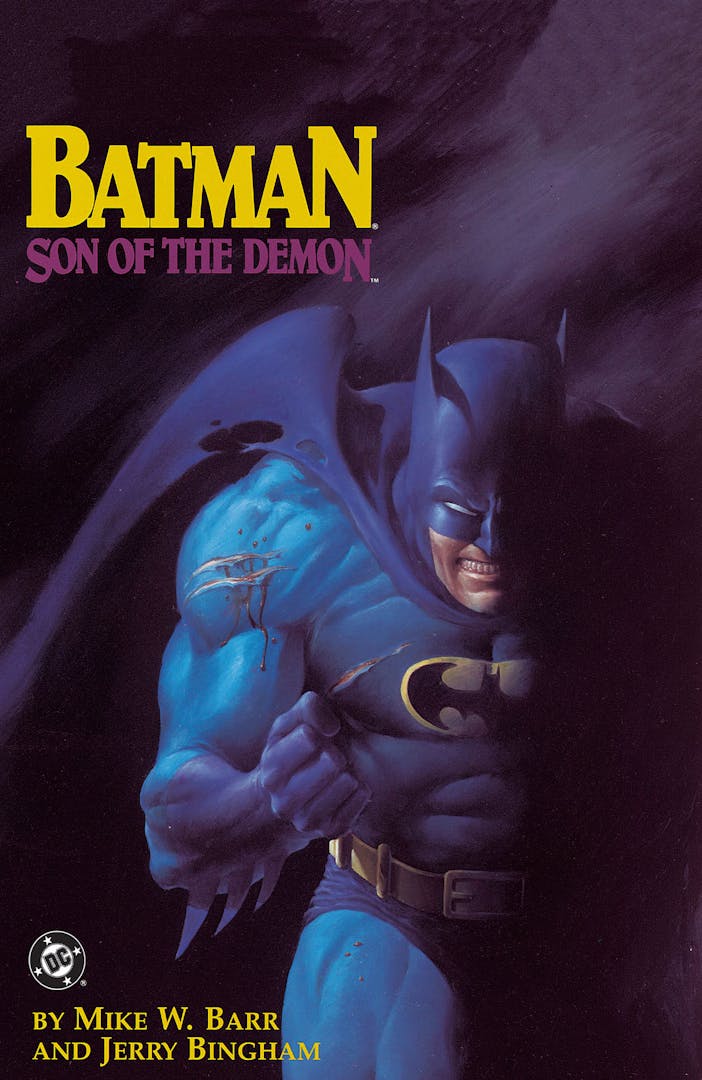
JJ asks:
What was Batman’s first ever graphic novel?
I think that depends on how you define a graphic novel. The first published collected edition of Batman stories in a bound book format was Batman: Now America's No. 1 TV Hero, published by Signet Books in 1966. It was a small, black-and-white collection of Batman's origin story from Detective Comics #33 and a handful of stories from the 1950s to tie into the exploding popularity of the Batman television show. The first instance of a previously published Batman story arc being republished into a collected format was The Untold Legend of The Batman in 1982, two years after its original publication in three issues. Five years later, 1987's Batman: Son of the Demon would be the first original Batman graphic novel.
Silent King Mefilas asks:
What happened to Morgan Edge after Kirby’s run on Superman’s Pal, Jimmy Olsen? Supes and the Newsboy Legion realize there is something up with him, but as far as I’m aware he is never dealt with after Kirby’s final issue, #148.
If you just hang out with Jimmy for just a few more issues after Kirby’s departure, you can find that out for yourself. Right after moving on to other projects, E. Nelson Bridwell stepped in to finish the Morgan Edge story. It’s there that we learn the Morgan Edge who appears in Superman's Pal is actually a clone of the true Edge, created by Simyan and Mokkari at Cadmus. In Superman’s Pal #152, the suspicious Edge clone dies while attempting to assassinate the genuine article.
DEWLine asks:
Have hometowns ever been established for Terry Sloane or Michael Holt?
Before he died, the original Mr. Terrific used to operate out of New York. Although he does tend to travel, as of Mr. Terrific: Year One, it appears that Michael Holt was originally based in Gateway City.

JJ asks:
What was the purpose of the Shadow of the Bat series from the ’90s?
Just a basic lesson in supply and demand. With fervor for Batman higher than it ever was before in the wake of the Tim Burton Batman duology, the growing comic market had space for an additional Batman title. Legends of the Dark Knight, a series set earlier in Batman’s career which was also being published at the time, allowed for new Batman books three weeks out of every month alongside Batman and Detective Comics. So, just as Superman during this time had four monthly books to keep Superman readers coming back to the comic shop every week, Alan Grant, who had already established himself on the main Batman title, was moved to a new Batman series of his own. It was all so that readers could get Batman titles just about every week of the year. Well, maybe that wasn’t the only reason, but capitalism definitely played its part.
Rod, Lord of the Dance asks:
What was the first appearance of Dabney Donovan, the evil ex-head of Project Cadmus? I know he's mentioned, but not seen, in Kirby’s ’70s stuff, then later writers built off that reference to actually show him in the flesh, but I don't know precisely when and where.
We get our first look at Dabney Donovan in 1990's Secret Origins #49, nearly twenty years after Kirby first mentions him.
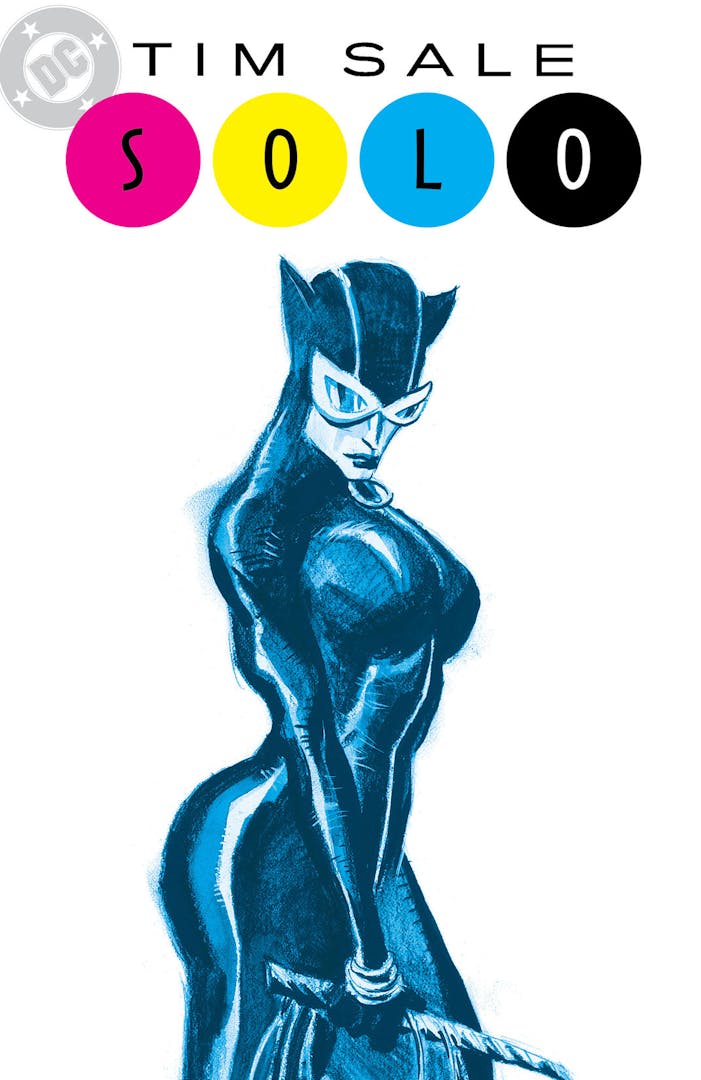
Seraph asks:
Outside of The Long Halloween, Dark Victory, When in Rome and For All Seasons, what DC Comics has Tim Sale done interior art for?
If you’d like to get a further look at Sale’s distinguished, signature style, the best places to do so within DC are as follows:
Challengers of the Unknown (1991)
Batman: Legends of the Dark Knight #32-34, "Blades" (1992)
Batman: Shadow of the Bat #7-9, "Misfits" (1992)
Batman: Legends of the Dark Knight Halloween Special #1-3 (1993-1995)
Showcase '94 #3-4, "Arkham: Madmen Across the Water"
Heartthrobs #1, "Diagnosis" (1998)
JSA: All-Stars #2, "The Same Thing Happens Every Night" (2003)
Solo #1 (2004)
Superman Confidential #1-5, #11, "Kryptonite" (2007)
Additionally, Sale also penciled 1994’s Deathblow #3-13, which was technically an Image series at the time, but some might consider that a DC title now post-WildStorm acquisition.
Felix Faust asks:
How many reboots has the DC Universe had? By reboot I mean wiping the slate clean and starting completely over.
While DC continuity has gained a certain reputation for reboots over the years, if you define one under those exact terms, then technically, it’s never happened. There was never a clean break between the Golden and Silver Ages of comics, especially for characters who persisted in publication from the 1940s to the 1950s. Crisis on Infinite Earths was a major reset for characters like Superman and Wonder Woman, but other titles, like The New Teen Titans, continued largely unaffected. Even the sweeping changes of the New 52 after Flashpoint came with exceptions, like those made for Geoff Johns’ Green Lantern and Grant Morrison’s Batman, Inc. While details may change, the story always continues ever onward.
Inmate08_01 asks:
I see Wally West is the current Flash, but how did Barry Allen lose his powers?
In the Absolute Power event last year, Amanda Waller commissioned a fleet of Amazo robots to drain everyone’s powers. Most got them back afterwards, but a few heroes’ powers are still MIA. Barry is one of them.
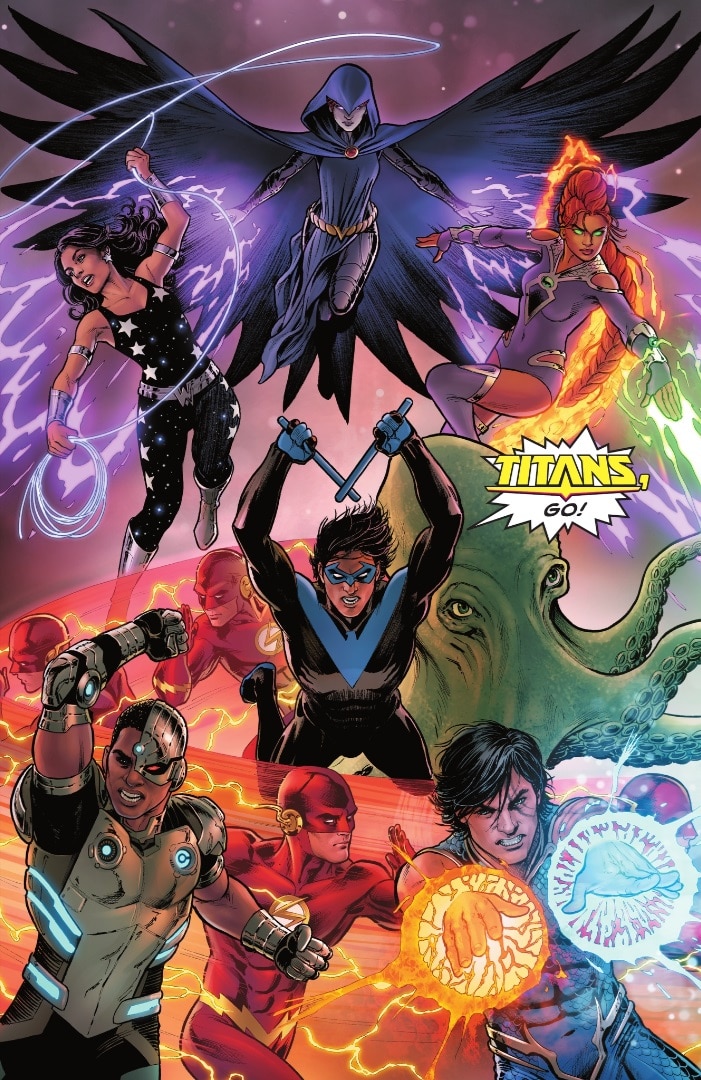
DC Ninja asks:
I’m trying to understand how Wally West’s return in DC Rebirth relates to the restoration of the Teen Titans’ history, especially the original New Teen Titans lineup with Starfire, Raven, Beast Boy and Cyborg.
In the New 52 reboot, these characters were younger than Nightwing and Wally, and Cyborg was part of the Justice League. How exactly did Wally’s return help restore their shared history and age dynamics?
A lot of this is touched on in the DC Universe: Rebirth special. Wally’s return is symptomatic of a greater reality shift, implied at first and then directly attributed to direct interference by Doctor Manhattan in Doomsday Clock. Between the DC Universe: Rebirth comic and the current Titans, Wally explains the “lightning rod” effect, where exposure to elements of the time that was taken from them in the New 52 can lead to a chain reaction that reawakens lost memory, as reality itself untangled from the events of Flashpoint.
But if we’re being real, the creators just missed working with the old dynamic, and it’s what the readers wanted, so they just brought it back.
Alexandrite1234 asks:
What's stopping just anyone from using Johnny Quick's speed formula? Like is there something that makes it so it only works for him?
This is where the “metahuman” factor of the DC Universe comes in. As we first learn in the 1988 Invasion! storyline, a certain subset of humans are born with genetics that allow them to harness certain forces that most people could not. If someone without Barry Allen’s metagene was subjected to the accident that gave him his powers, for example, nothing special would have happened to him. (Or, he might have just died.) Johnny Quick is uniquely able to tap into the Speed Force using his formula because he has the permutation of the metagene that allows him to do so.
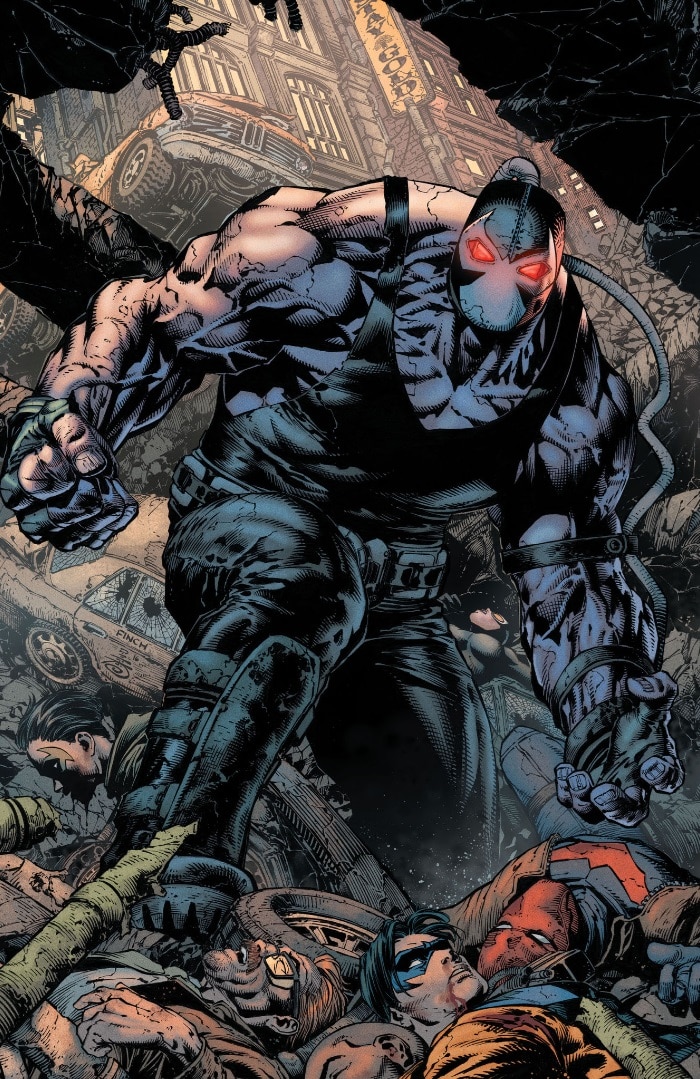
Stikmigenicetea asks:
Does Bane feel pain when “transforming”?
All indication appears to be the opposite. The process of undergoing the effects of venom are usually depicted as euphoric, and even addictive for those who use it. Both Batman: Venom and Bane’s personal story arc in Gail Simone’s Secret Six series contend with the difficulty of kicking the venom habit.
Dragon Moth asks:
What would you say is the DC comic that best encapsulates each of the ages of comics?
Batman.
Superthebillybob asks:
Is Alan Scott the earliest published DC character depicted as queer? And then to follow-up, are there any depictions of queer characters that pre-date Monsieur Mallah and the Brain?
Retroactively speaking, yes. Though Alan Scott wouldn’t be depicted as queer until 2012 in Earth-2.
The first queer DC characters as introduced were probably Cannon and Saber, a pair of villains from Marv Wolfman’s Vigilante run in 1984, though even that was mostly implied. Comics Code policy did not officially allow the inclusion of queer characters in comics under their authority until 1989 (though there was some testing boundaries shortly before that repeal, such as in the case of Maggie Sawyer).
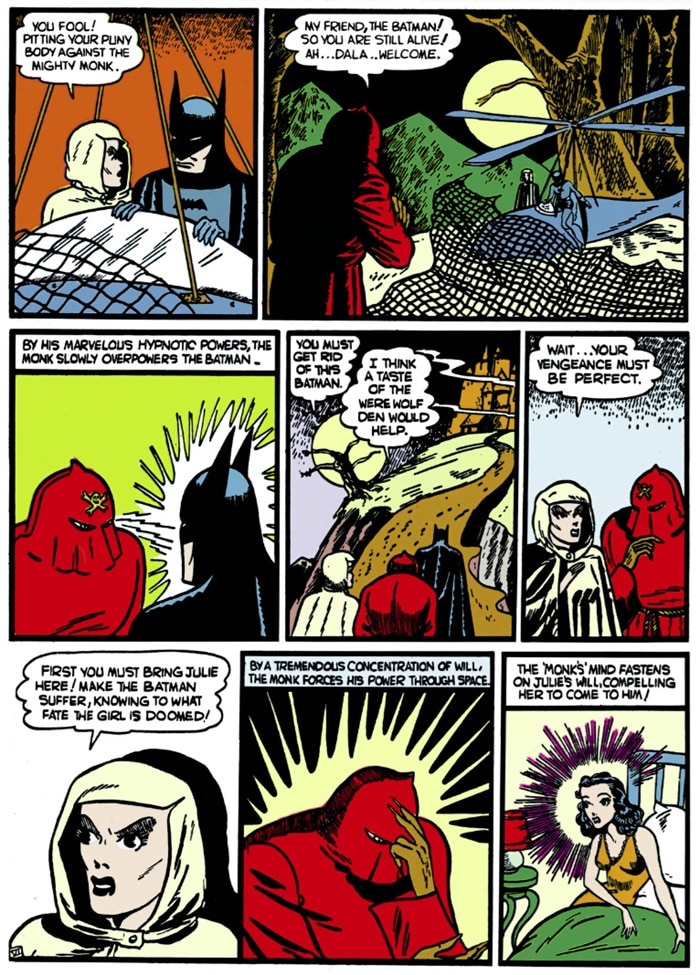
DrWhoDidle asks:
Who is considered Batman’s first costumed supervillain?
Though not his first recurring villain (that would be Doctor Death), the first of Batman’s enemies to wear a special costume was the Mad Monk, a vampiric entity he contended with—and killed, before his stance on that had been codified—in 1939’s Detective Comics #31-32.
Comedy Alpha asks:
Was it ever mentioned what happened to Lois Lane during the events of Batman Beyond?
Not in the show itself, but some of the tie-in comics do offer some clues. (We won’t get into the “canon” status of those comics here, but in short, assume they were written with the intentionality of being considered in conversation with the story of the animated series.)
In 2010’s Superman/Batman Annual #4, we learn that Lois died ten years before Terry became Batman and Superman has been mainly retired from public life ever since. Later entries in the Batman Beyond comic library explore Superman slowly returning to active duty and rebuilding a life without her. But the exact circumstances of her death remain a mystery.

AfterDark asks:
How does the Joker feel about Damian compared to the other Robins?
This is explored a little by Peter Tomasi in his “Death of the Family” tie-in, where it seems like Joker tends to group Robins not by individual identity, but just how old they are. Ultimately, I think it’s fair to say that Joker essentially sees the Robins as interchangeable. They range for him from a mere nuisance to a tool to needle Batman.
Lyymon asks:
Any tips for someone who is new to comics?
Here’s my sincere answer to that, which I tell everyone starting out: don’t worry about reading orders. Don’t worry about missing context, or about starting at issue one, or anything you think you might be missing. Quell the fires of FOMO within your heart and simply embrace the unknown. The greatest joy of DC Comics is that no two people’s journeys through it are exactly alike. Everything you read may throw all you’ve tread before into new light. It’s nonlinear and it’s beautiful.
And, of course, should you ever find yourself too lost to continue, you can always ASK…THE QUESTION.
Alex Jaffe is the author of our monthly "Ask the Question" column and writes about TV, movies, comics and superhero history for DC.com. Follow him on Bluesky at @AlexJaffe and find him in the DC Official Discord server as HubCityQuestion.
NOTE: The views and opinions expressed in this feature are solely those of Alex Jaffe and do not necessarily reflect those of DC or Warner Bros. Discovery, nor should they be read as confirmation or denial of future DC plans.
